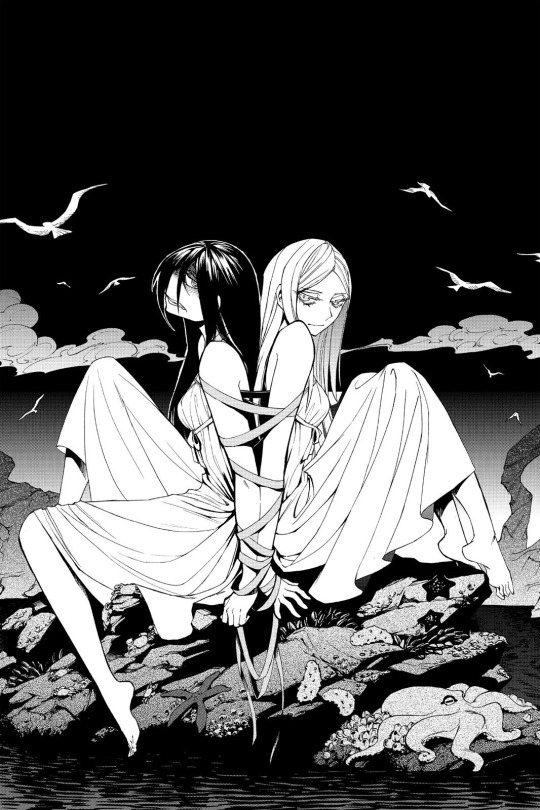#tanzawa
Explore tagged Tumblr posts
Text
Create and foster beauty within—then it will accompany you wherever you go
(Book (Jumbo Jumble) - December 26)

Ooyamadera Temple (Yabitsu Touge Bus Stop (35 minutes by bus from Hadano Station (Odakyuu Line), 3 hours, 2012)
Mt. Oyama is one of the famous mountains in the Tanzawa range just over an hour from Tokyo. It’s only about an hour’s walk up to the top from the Yabitsu Rouge Bus stop and there are beautiful views from the top. This temple is on the way down the mountain, and near a cable car stop where you can take a cable car down if you wish (or hike down). A wonderful day trip!
1 note
·
View note
Text

Kasane
Daruma Matsuura
#kasane#daruma matsuura#manga#mangacap#seinen#drama#psychological#supernatural#tragedy#acting#kasane fuchi#neena tanzawa#monochrome
21 notes
·
View notes
Text







Once again, doing my part in keeping the out fandom breathing by posting once a year. I forgot the other characters so I'm re-reading in hopes that I'll remember them.
#out manga#out makoto mizuta#iguchi tatsuya#atsushi tanzawa#other characters I don't remember#fuck i need to re-read the series#jousuke minagawa
26 notes
·
View notes
Text




Mt. Tanzawa (2) (3) (4) by ymmooot
#deer#trees#forest#mountains#grasses#snow#frost#cloudy#tanzawa mountains#japan#kanagawa prefecture#shizuoka prefecture#yamanashi prefecture
4 notes
·
View notes
Text

#upload!#mangaposting#bonus art#color#touka nijou#nijou touka#tanzawa chizuru#chizuru tanzawa#sana komori#komori sana#haru tendou#tendou haru#kyou kara ore wa loli no himo!#kyou kara ore wa loli no himo#loli no himo!#loli no himo#henreader
3 notes
·
View notes
Text

Neeeeeed

He’s so cute
2 notes
·
View notes
Text

Today’s disabled character of the day is Nina Tanzawa from Kazane, who has Kleine-Levin syndrome and was in a coma
Requested by Anon
[Image Description: Black and white drawing of a women facing the viewer with long light colored hair. She is wearing a light color shirt and has thick eyelashes.]
3 notes
·
View notes
Text

MIKE in his YaTuSabe Leopard Denim Trucker
Photo by Ryosuke Tanzawa
1 note
·
View note
Text
youtube
Navy Blue - Take Heed Memoirs In Armour - Produced by Budgie Directed by Ryosuke Tanzawa
0 notes
Text
a bigger interest of mine recently has been Kasane. as with everything else i like, i want to incorpate it into TWST in a way.
more under the cut
because of the existence of magic in TWST, id like to believe the powder found in the lipstick is obtainable.
maybe the powder could be found on Sages Island? or maybe the Queendom of Roses. Itd still be incredibly hard to obtain either way. (unless Sams Shop is in question.. i think itd cost a ton though)
the first person to come to mind on who would use the lipstick in the first place would be Vil.
-do i think that just because hes an actress ? yeah..
but still, theres a possbilty of following a similar timeline as there is in Kasane. theres no way to replicate that though.
i think Vil is listed as an only child, but what if he had a sibling nobody knew about?
his mother isnt mentioned at all from what ive seen, but maybe she had left the lipstick behind? rather then the abusive father that Nogiku had to deal with, Vils father worked to raise him (and a possible sibling) with the utmost care.
with Vil being interested in acting and such, that couldve enabled his father to encourage swapping faces with his (supposed) sibling, due to the industry being heavy on looks.
or, Vil is not actually Vil. sorta like how when Nogiku swapped faces with Kasane, her stage name was Saki. maybe he would go through something similar?
for Habutas role though, i feel like Jack would be a good fit.
others i think that would use the lipstick would be Kalim and Jamil. Kalim doesnt have any evil motive behind his use of it, just using it behind his family had ordered him to. i would imagine Jamil to experience similar emotions to Neena, in a way atleast. this would be sorted at birth though, so it might just be normal for them.
another would be Cater.
-why ? just because. or maybe one of his sisters would use the lipstick on him. idk honestly Cater just kinda gives that vibe
#twisted wonderland#kasane#kasane fuchi#nogiku fuchi#neena tanzawa#vil schoenheit#jamil viper#kalim al asim#jack howl
0 notes
Text

Alpine Black Swallowtail (Papilio maackii), family Papilionidae, Tanzawa Wild Park, Yamakita City, Japan
photograph by Massae Kiyomura
575 notes
·
View notes
Text
Hope combined with good works unleashes a dynamic force.
(Book (Jumbo Jumble) - October 24)

Yuujo no taki Waterfall (Surugaoyama(Gotemba), 1 hour, 2009)
This is one of the most beautiful waterfalls in the Tanzawa area (the mountainous area between Tokyo and Hakone). It’s a wonderful place to enjoy lunch while feeling the positive energy of the gushing water. For you hikers, there is a good hiking course (about 3-4 hours) from the falls to Ashigara station (which has a hot springs nearby if you wish to take a dip).
0 notes
Text



Sean bienvenidos japonistasarqueologicos a una nueva entrega de arqueología nipona. En esta ocasión nos volvemos al periodo Jomon(1600/300 a.c), nos vamos a la prefectura de Kanagawa, a la ciudad de Hadano en la cual se ha encontrado una tumba del periodo Jomon¿Cuándo surgen las tumbas en Japón? Ya responderemos esta pregunta para una próxima publicación. - ¿De cuándo data el asentamiento? data de finales del periodo Jomon(3500-4000) que es un periodo que duró más de 10.000 años, hay unas 40 viviendas en un futuro, se estima que pueda haber más de las encontradas actualmente, dicho asentamiento se localiza al lado del río Mizunashi cerca de la montaña Tanzawa. - El yacimiento arqueológico se localiza a 2,5 km de la estación de tren Shibusawa, el conjunto arqueológico tiene una dimensiones de 28.000 metros cuadrados y 20 viviendas son de tipo Ekagami. Se han encontrado una hilera de piedras de 10 a 20 metros que desempeñó la función para separar las ruinas de la vivienda, es similar a un muro de piedra, en su interior se ha hallado material ritual con forma de maniquí, también hay una hilera de piedras de 50 metros posiblemente sea una conexión con la aldea. - ¿Qué otros restos se han encontrado? 30 hogueras más huesos de bestias triturados, figuras de arcilla con forma de mujeres y 554 cajas de almacenamiento, posiblemente para algún tipo de ritual y cuto. Se han encontrado equipos de pesca. - Espero que os haya gustado y nos vemos en otra noticia de arqueología nipona ¿Qué opinan ustedes? - 考古学のジャポニスタは、日本の考古学の新作へようこそ。 この機会に縄文時代(紀元前1600/300年)に戻り、縄文時代の墓が発見された秦野市の神奈川県に行きます。日本ではいつ墓が出現しますか?今後の出版のためにこの質問に答えます。 - 決済日はいつですか? 10、000年以上続いた縄文時代(3500-4000)の終わりからの日付で、将来的には約40戸の家があり、現在見つかっている家よりも多いと推定されています。丹沢山近くの水梨川の隣。 - 遺跡は渋沢駅から2.5kmに位置し、28,000平方メートルの広さで、20戸の家屋がエカガミタイプです。廃墟と家を隔てる10〜20メートルの石列が発見されました。石垣に似ており、内部にはマネキンの形をした儀式用の材料が発見されています。 50メートルの石はおそらく村への接続です。 - 他にどのような遺物が見つかりましたか? 30の炉床に加えて、砕いた獣の骨、女性の形をした粘土の人形、554の収納ボックス、おそらく何らかの儀式や求愛のために。釣り道具が見つかりました。 - あなたがそれを気に入って、別の日本の考古学ニュースであなたに会えることを願っています。あなたはどう思いますか? - Japanese archaeologists are welcome to a new installment of Japanese archaeology. This time we return to the Jomon period (1600/300 BC), we go to the Kanagawa prefecture, to the city of Hadano where a tomb from the Jomon period has been found. When do graves appear in Japan? We will answer this question for a future post. - When does the settlement date? dates from the end of the Jomon period (3500-4000) which is a period that lasted more than 10,000 years, there are about 40 houses in the future, it is estimated that there may be more than those currently found, said settlement is located next to the Mizunashi river near Tanzawa Mountain. - The archaeological site is located 2.5 km from the Shibusawa train station, the archaeological complex has a size of 28,000 square meters and 20 houses are of the Ekagami type. A row of stones of 10 to 20 meters has been found that served to separate the ruins from the house, it is similar to a stone wall, inside it has been found ritual material in the shape of a mannequin, there is also a row of 50-meter stones possibly a connection to the village. - What other remains have been found? 30 hearths plus crushed beast bones, clay figures in the shape of women and 554 storage boxes, possibly for some kind of ritual and courtship. Fishing equipment has been found. - I hope you liked it and see you in another Japanese archeology news. What do you think?
#考古学#歴史#ユネスコ#文化#写真#日本#縄文時代#先史時代#神奈川県#地理#芸術#archaeology#history#unesco#culture#photos#japan#Jomonperiod#prehistory#Kanagawaprefecture#geography#art
22 notes
·
View notes
Text
(241119) [making of] snow man's iwamoto hikaru climbs mt. daisen in tanzawa|tarzan magazine no. 891, from the serialization "treacherous muscle training method" (1, 2)
#snow man#snowman#snm#iwamoto hikaru#hikaru iwamoto#v: making of#tarzan#v: magazine#type: magazine#岩本照
8 notes
·
View notes
Text






[Có thể bạn đã biết] Phân biệt hạt dẻ, hạt dẻ ngựa và hạt sồi.
Mùa “chôm chôm” ở Nhật đang tới và các bạn mới sang hẳn sẽ rất háo hức khi bất chợt trên đường ra công viên nhìn thấy một loại quả rụng rất nhiều, trông rất giống “hạt dẻ”. Nhưng hãy cẩn thận, bởi một số loại quả này có chứa chất độc hoặc sẽ khiến bạn tốn tiền điện cho việc luộc chúng mà không thể ăn được vì cứng như đá. 🥹
1. Hạt dẻ (和栗/ Castanea crenata):
- Hạt dẻ là cây thân gỗ rụng lá thuộc họ Fagaceae, đã xuất hiện ở Nhật Bản từ rất lâu. Hạt dẻ được chia thành hạt dẻ Nhật Bản, hạt dẻ Trung Quốc, hạt dẻ thơm châu Âu và hạt dẻ Mỹ. Trong số này, hạt dẻ Nhật Bản đặc biệt lớn và là phiên bản cải tiến của hạt dẻ Shiba bản địa.
- Hạt dẻ Nhật Bản có lịch sử lâu đời và người ta tin rằng hạt dẻ đã được trồng từ thời Jomon (縄文時代). Nghiên cứu về tàn tích cho thấy cây hạt dẻ được sử dụng làm nguyên liệu chế tạo công cụ và làm nhiên liệu.
- Trong thời kỳ Sengoku, kachiguri (勝ち栗), là một loại thực phẩm được bảo quản bằng cách hấp hạt dẻ và giã trong cối đá, sau đó sấy khô để sử dụng làm thức ăn trong trại với mục đích cung cấp dinh dưỡng và đem lại may mắn cho binh sĩ nên kể từ thời kỳ này, hạt dẻ được trồng ngày một phổ biến.
- Thông thường, hạt dẻ bắt đầu được thu hoạch vào khoảng giữa tháng 8 và vào mùa từ tháng 9 đến tháng 10. Thế nên, khi hạt dẻ xuất hiện, người ta biết rằng mùa thu sắp về.
- Các giống hạt dẻ phổ biến ở Nhật hiện nay là: Hạt dẻ Tsukuba (筑波栗), hạt dẻ Ginyose (銀寄席栗), hạt dẻ Tanzawa (丹沢栗), hạt dẻ Riheiguri (利平栗).
- Hạt dẻ Tsukuba (筑波栗) là một giống hạt dẻ lai tạo được trồng nhiều nhất ở Nhật Bản vì số lượng thu hoạch ổn định. Thịt chứa nhiều bột, có vị ngọt đậm và mùi thơm nồng nàn. Quả có kích thước trung bình, màu vàng nhạt. Chất lượng thịt tốt. Mùa vụ từ cuối tháng 9 đến đầu tháng 10.
- Cách chọn hạt dẻ ngon là chọn hạt dẻ to tròn đều, vỏ sáng bóng và n��u sẫm. Nếu có lỗ hoặc đốm đen thì có thể có côn trùng ẩn náu bên trong hạt dẻ. Vì thế khi mua hạt dẻ về hãy ngâm nước, nếu hạt nổi lên là bị sâu mọt ăn.
🔖Cách chế biến: - Hạt dẻ có xu hướng mất nước tự nhiên sau khi tách bỏ lớp vỏ gai bên ngoài, vì thế ngay sau khi thu hoạch, các bạn nên chế biến để giữ được độ tươi mọng và ngon ngọt nhất.
🔖 Cách luộc hạt dẻ dễ tách vỏ như sau:
- Ngâm hạt dẻ trong nước ấm 50-60 độ trong khoảng 60 phút. Vớt hạt dẻ bỏ vào nồi, đổ ngập nước, thêm vào 1/2 thìa cà phê muối. Thêm muối sẽ giúp hạt dẻ tăng độ ngọt đậm.
- Để lửa trung bình, luộc trong khoảng 30-40 phút. Khi hạt dẻ mềm, tắt bếp, ngâm hạt dẻ trong nồi nước sôi thêm 15 phút.
- Vớt hạt dẻ ra rổ, để hạt dẻ nguội bớt. Khi hạt dẻ còn hơi ấm, lấy dao cắt bỏ phần đít của hạt dẻ. Sau đó, bạn có thể dễ dàng lột bỏ lớp vỏ cứng bên ngoài bằng cách tách từ dưới lên. Còn lại lớp da mỏng bên trong, dùng dao gọt như gọt táo. Cuối cùng, bạn có thể trữ đông để sử dụng cho các món ăn từ hạt dẻ.
2. Hạt dẻ ngựa (栃の実/Horse chestnut):
- Hạt dẻ ngựa là cây gỗ rụng lá thuộc họ Aesculus turbinata, xuất hiện ở Nhật Bản từ rất lâu. Phân bố ở Hokkaido (phía nam Sapporo), Honshu, Shikoku và Kyushu. Hạt dẻ ngựa có tên tiếng Anh là Horse chestnut, tiếng Pháp là marronier(マロニエ).
- Hoa của hạt dẻ ngựa chứa nhiều mật nên được trồng để tạo ra mật ong chất lượng cao, thân làm gỗ và quả hạt dẻ ngựa có thể dùng làm xà phòng, dược phẩm.
- Hạt dẻ ngựa có đặc điểm là khi còn trên cây, quả màu xanh, có gai ngắn. Quả có màu xanh và chứa một (hiếm khi hai hoặc ba) hạt bên trong vỏ có gai. Hạt có đường kính 2-4 cm, màu nâu đỏ sẫm bóng, phần đít hơi trắng. Điểm khác biệt lớn nhất là hạt dẻ có đầu nhọn, còn hạt dẻ ngựa không có đầu nhọn và nhẵn, thường không tròn đều.
- Hạt dẻ ngựa có tính đắng, chát do chứa nhiều saponin và tannin, nên không thể ăn đơn giản bằng cách luộc hoặc rang thông thường.
- Nhật Bản được xem là quốc gia duy nhất có truyền thống chế biến hạt dẻ ngựa thành các món đặc sản. Để có thể ăn được, vị đắng chát phải được loại bỏ, nhưng quá trình này tốn rất nhiều công sức. Tỉnh Ishikawa và Fukui là những tỉnh có món hạt dẻ ngựa ăn được rất phổ biến. Ở vùng núi Echizen (越前市), hạt được ngâm nước trong 30 ngày, sau đó bóc vỏ và đun sôi trong dung dịch kiềm để tạo thành bột rồi trộn với gạo nếp, gọi là tochi mochi (栃餅). Bánh tochimochi thường được sử dụng vào dịp năm mới.
3. Quả sồi Sudajii (スダジイ/すだ椎):
- Tên khoa học: Castanopsis sieboldii. Họ: Fagaceae, chi Castanopsis.
- Phân bố: Honshu (phía tây Fukushima và Niigata), Shikoku, Kyushu, Okinawa. Ở Kansai gọi là Tsuburajii (ツブラジイ), Okinawa là Itajii (イタジイ).
- Cây Sudajii thường trồng để lấy gỗ hoặc nuôi trồng nấm hương. Đây cũng là cây được trồng làm “rừng bảo vệ” tại các đền, miếu, trường học, công viên.
- Từ cổ xưa, người Nhật đã biết sử dụng Sudajii để làm thực phẩm. Quả Sudajii có vị ngọt bùi, thơm ngon, có thể luộc, rang như hạt dẻ và dùng làm bánh.
Ảnh: Google
3 notes
·
View notes
